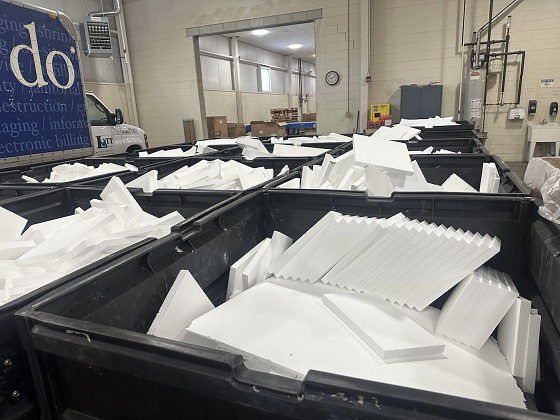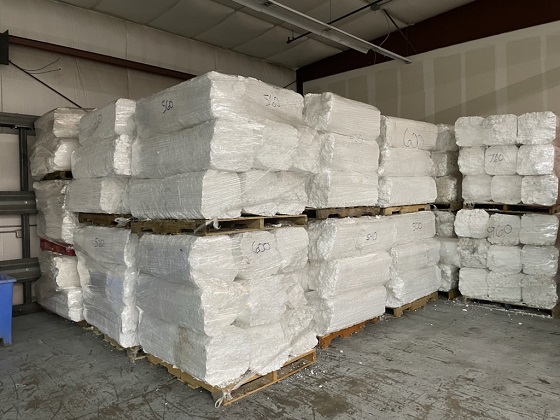Polystyrene Recycling | Guide to Polystyrene Disposal
Since its exploration in 1839, the versatile plastic polystyrene has found global charm, being made into toys, food boxes, packaging products, insulation and even more. With an approximated 15.6 million tons generated annually, what happens at the end of its life span? Is polystyrene recyclable?
In this blog, we'll explore how to dispose of polystyrene. First, let's take on the main question: Do you know which polystyrene you're disposing of?

How to Identify Polystyrene
Polystyrene is among the most widely used plastics. It can be found as solid plastic, or rigid foam. Its capability to be created in any type of color and a variety of types makes it a typically used material, and our group receive regular enquiries from clients keen to know how and where their particular polystyrene product can be disposed of.
General Purpose Polystyrene (GPPS).
This kind of polystyrene is a thermoplastic polymer, which implies it can be softened via heating, molded into shape and afterwards left to cool down and harden.
Its capacity to be both transparent and rigid makes it a prominent selection for polystyrene product packaging for food, cosmetic packaging, medical devices and toys.
High Impact Polystyrene (HIPS).
High-impact polystyrene is a thermoplastic polymer made from a mix of polystyrene and rubber. By consisting of rubber, the result is a tough and impact-resistant plastic.
From polystyrene packaging to car components, toys and kitchen appliances, HIPS plays a significant role in daily life.
Extruded Polystyrene (XPS).
To create this type of plastic, polystyrene granules are mixed with special additives and foaming agents at a particular temperature level and pressure. These are pushed with a specialist shape called a die. This produces a closed pore structure where air is locked and sealed. With its high thermal and moisture resistance, XPS is most frequently made use of for insulating buildings.
Expanded Polystyrene (EPS).
This kind of plastic is produced from solid beads of polystyrene, which have a small amount of expansion gas. These expand when heated up and can be molded to form large foam blocks and customized into shapes.
As EPS is 98% air, it is extremely light and has low thermal conductivity. But it is also tough, making it a popular choice for packaging. From protecting food to keeping fish products cool and delivering new appliances, polystyrene packaging solutions have been solving delivery problems for years.

Are Polystyrene and Styrofoam the same thing?
Styrofoam is a trademarked name for polystyrene foam, XPS. The business brand name Styrofoam is usually utilized in building and construction. Although it can puzzle the polystyrene world, consider it similar to how the brand name Hoover has actually taken over utilizing the term 'vacuum cleaner'.
Now that we're clear on the different sorts of polystyrene let's look at disposal approaches.
Is Polystyrene Recycled in Australia?
All kinds of polystyrene can be reused in Australia. The current figures show that over 100 tons of EPS are recycled monthly. Even CD and DVD situations made from GPPS can be recycled at specialist facilities.
With the price of garbage dump tax having risen to $ 103.70 per ton on 1 April 2024, it's not only eco-friendly to recycle polystyrene but also becoming a lot more profitable. Businesses can make up to $ 600 per ton of recycled polystyrene. In France, the potential for recycling polystyrene is considerable. Yet, it encounters difficulties such as its bulkiness, the requirement to be devoid of contaminants, and possible high costs related to the reusing process.
At GREENMAX, we can arrange, clean and recycle your polystyrene and guide you to which polystyrene is recyclable in your area. We can manage the entire process from start to finish. Find out more today.

Choose recycling machines for your company
Your polystyrene waste challenge might seem complex, yet several options are offered to companies to ensure your waste is dealt with.
Polystyrene compactor: To collect enough polystyrene to make it worthwhile for recyclers to buy it, consider purchasing a polystyrene compactor. They transform vast quantities of polystyrene into neat blocks, reducing volume by 90%.
Polystyrene Pelletizer: Polystyrene pelletizer is also called waste polystyrene pellets recycling machine, which can produce foam pellets without destroying the original molecular structure, and the pellets produced are extensively used. EPS pelletizer is the waste EPS foam through crushing- melting- pumping- cooling- granulation and other processes, the final product into pellets.

Why Do We Need to Dispose Of Polystyrene Responsibly?
In January 2024, the coasts of Lake Tahoe in California were dusted with a white layer that resembled snow. As curious locals went to explore, they found thousands of little EPS beads covering the sand.
A winter season tornado had broken up a polystyrene floating dock, releasing pollutants into the water and posing severe threats to the aquatic life and health of the environment.
When polystyrene is not disposed of responsibly, it can cause severe problems. Polystyrene packaging plays a vital role in decreasing food waste by protecting items, extending the shelf life of perishable products, and making certain the safe transport of food, consequently reducing food waste in the food services industry. However, using creative methods to recycle waste polystyrene is vital to avoid it from causing environmental harm, given its slow biodegradability and the challenges associated with recycling waste polystyrene on both a local and global scale.
Polystyrene can occupy to 500 years to break down, and there are worries that damaging chemicals are leached into the soil and waterways as they decompose in landfills.
The approximated stats surrounding polystyrene are grim:.15.6 million tons of polystyrene are produced each year.
30% of land fill waste is polystyrene.
20% of general trash is polystyrene.
And only 12% of polystyrene is recycled.
Conclusion
Polystyrene is commonly used in numerous industries, including food packaging, and is extensively recyclable in France. Nevertheless, only 12% is recycled.
The good news is that companies can use an experienced waste management company to find recycling solutions. This isn't just good for the environment but also profitable—businesses can make up to $ 500 per ton of recycled polystyrene by selling it to the INTCO Recycling.
Let's work together to create a future that's a few shades greener.
